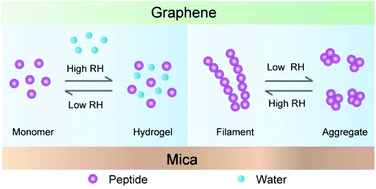Assembly of peptides in mica–graphene nanocapillaries controlled by confined water†
Abstract
Water in nanoscale-confined geometries has unique physicochemical properties in contrast to bulk water, and is believed to play important roles in biological processes although there is less direct information available in the literature. Here, we report the self-assembly behaviors of a neurodegenerative disease related peptide termed GAV-9 encapsulated in mica–graphene nanocapillaries interacting with water nanofilms condensed under ambient conditions, based on atomic force microscopy (AFM) imaging and molecular dynamics (MD) simulations. The results revealed that, upon increase in the humidity, the GAV-9 peptide monomers adsorbed the confined water molecules and transitioned to unexpected hydrogel-like structures. Our MD simulations also suggested that in the confined mica–graphene nanocapillaries, the GAV-9 peptide monomers would indeed form water-rich hydrogel structures instead of highly ordered nanofilaments. The interfacial water confined in the mica–graphene nanocapillary is found to be crucial for such a transition. Moreover, the distribution of confined water layers largely depended on the locations of the preformed peptide nanofilaments, and the peptide nanofilaments further assembled into nanosheets with the water layer increasing, but depolymerized to amorphous peptide assemblies with the water layer decreasing. The polymerization and depolymerization of the peptide nanofilaments could be controlled in a reversible manner. Our results have supplied a simplified model system to uncover the effects of the confined interfacial water on the biological process at the molecular level.



 Please wait while we load your content...
Please wait while we load your content...